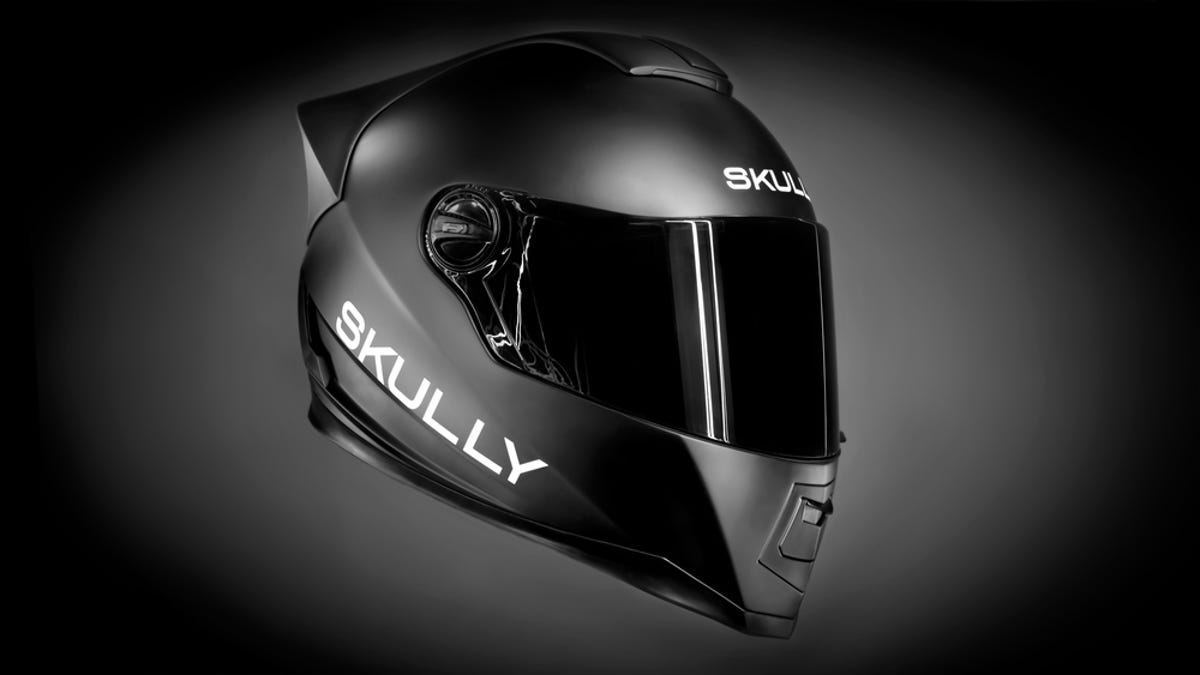Skully opens preorders for high-tech, safety-focused helmet
Due in 2015, Skully's motorcycle helmet, with a built-in virtual-reality display, won't come cheap. But it may save your life.

Skully's augmented-reality motorcycle helmet has taken a big step toward becoming a reality on the road, with preorders available starting Monday for the next month through IndieGoGo.
The Skully AR-1 is set to ship in mid-2015, and cost $1,399 when ordered in advance. (This converts to about £830/AU$1,500.) Full retail price after the preorders ship is expected to be about $100 more.
The IndieGoGo campaign blew through its goal of $250,000 in eight minutes, and by noon had nearly tripled that goal with 340 preorders.
Skully founder and CEO Marcus Weller told CNET that their office was "electric" this morning.
"Our team watched in amazement on the big screen this morning while the numbers kept rising. We are honored to have the opportunity to serve and transform this industry we love," he said. "We are looking forward to an exciting future for Skully."
The helmet, which debuted at the Demo conference last year and has won awards from Demo and South by Southwest Interactive, promises a truckload of features designed to make the rider safer. The most important one in Skully's Google Glass-style heads-up display is the 180-degree rear-view camera, which eliminates blind spots by using proprietary technology to eliminate the fish-eye effect.
The helmet also comes with visual and audio-cued GPS navigation, can be paired with your smartphone, and offers voice control.
In an interview last week, Weller told CNET that the Skully heads-up display is an "anti-UI."
"You don't interface with it when you ride," Weller said. "You just ride. We're not intervening. The interface is engineered so that it requires very little attention to use it."
Although the Skully AR-1 comes with an optics display that looks similar to Google Glass, there are marked differences between them. Google Glass sits above the user's eye, while the Skully's lies in the rider's line-of-sight to the right side mirror. Also, the AR-1 highly restricts access to the Internet. You can't browse the Web while lane-splitting at 70 miles an hour.
Weller said that Skully's approach is "fundamentally different" from Google Glass. "They're trying to create a new type of user interface that you use while walking around. We want to capitalize on the familiarity you have on your smartphone."
It will come with an Android and iOS companion app to configure ride settings before you get on your bike.
When you look down to your side mirror, for example, Weller said that you lose about one second with each glance to refocus your eyes. Skully's interface tricks the brain into thinking that the image is around 10 feet away from the rider, cutting the refocus time. And as any rider will tell you, one second is enough to be the difference between life and street pizza.
Weller's drive to build the Skully helmet comes from personal experience. After crashing his bike when distracted by a road sign in 2011, he decided to pursue an Internet-augmented helmet to improve rider safety.
"Every feature we have running on this has to work perfectly and be 100 percent safe," he said, before he'll sell the helmet.
Skully might be riding a dual wave of motorcyclist interest and tech fascination. Weller said that the original sign-up website opened a year ago gave Skully a mailing list of 145,000 curious riders. He doesn't expect all of them to cough up $1,400 in the next 30 days, but he says he is prepared for eager interest.
In addition to the proprietary, Skully-built Synapse heads-up display (HUD) system, the helmet is replete with goodies in its first generation. Weller's engineering teams have built a HUD with an "automatically infinitely" variable focal distance, but the HUD automatically adjusts to ambient light. Combined with the electro-chromic, polarized helmet visor, which dims to deflect direct sunlight at the touch of a button, Skully has taken steps to ensure that the HUD is always visible.
Whether riders take to it is another question, but in a casual, non-street demonstration of the visor and HUD brightness sensor working in conjunction with the rear-view camera, the technology appeared to perform as promised.
The Skully AR-1 shell is based on a lightweight model approved by major crash safety ratings groups, and will also come with visual cues for turn-by-turn navigation, water-resistance for the helmet's tech components, ventilation, NASA-sourced sweat-wicking fabric, and Bluetooth pairing with your smartphone.
Ride telemetry and voice control are due in software updates after the initial release, but it uses information gleaned from your phone's accelerometer and weather app to calculate your speed and display weather data.
Weller acknowledged that the helmets won't be cheap. They cost about the same as Google Glass or a Google Chromebook Pixel, but he remained confident that the technology introduced in the Skully AR-1 will change how motorcycle helmets are built.
"A couple of hundred people will have the ability to help improve something that will hopefully save thousands of peoples' lives," Weller said of his expected test base.
Although Weller occasionally has lent earlier Skully prototypes for public tests, the true evaluation of its success likely will come only through word-of-mouth once riders use it in the real world. Getting cutting-edge consumer technology to work in a lab is one thing. Having that tech save you from a careless car driver is as different as a bicycle is from a motorcycle.
Update at 12:15 p.m. PT with details and comment on the success of the IndieGoGo campaign.

